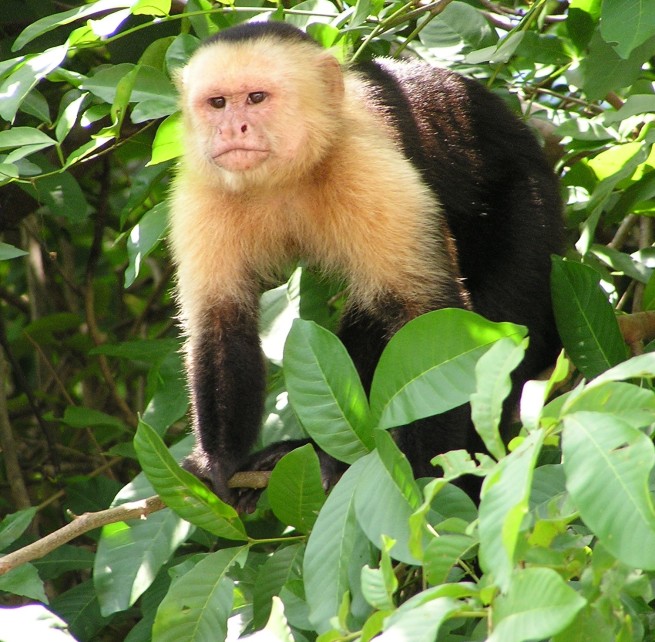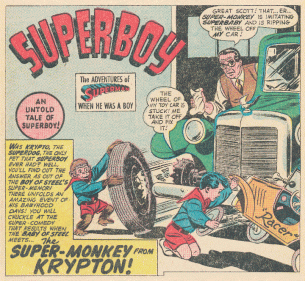
Monkey Day is celebrated internationally on 14 December. It was created by American artist Casey Sorrow in 2000. It
began as a in-joke between Sorrow and fellow art students at Michigan State University. Since then it has spread across the globe as a day to raise awareness and concern for the animals. Zoos in Estonia, Pakistan, and presumably elsewhere host Monkey Day events. Even Hallmark has apparently gotten in on the action.
Peter Jackson‘s King Kong was released on Monkey Day 2005 — although no monkeys are featured in the film. King Kong is, of course, a gorilla and as such no more a monkey than his human-costar, Jack Black. According to an article in The Times Leader, Monkey Day parties frequently include viewings of Planet of the Apes, another film which features no monkeys — a fact that should be evident by the fact that it’s not called Planet of the Monkeys.



In 2008, the official Monkey Day celebrations included an art show and silent auction to benefit the Chimps Inc. animal sanctuary. Chimpanzees, like gorillas and humans as well as orangutans, gibbons, gorillas, and bonobos are apes, not monkeys. In fact, the Wikipedia entry on Monkey Day includes exactly zero mentions of Monkey Day events which actually involve monkeys. It seems to me like raising a little awareness about monkeys might be in order.



Monkeys are, like apes, primates. Unlike apes, however, monkeys are usually much smaller and generally posses tales. There are about 260 known species, many of which are arboreal (although baboons live primarily on the ground). Lemurs, lorises, and galagos are not monkeys. Apes are not monkeys. The members of The Monkees are not actual monkeys and neither is Ian Brown. Baboons, capuchins, marmosets, tamarins, titis, sakis, and uakaris are monkeys.

The first astronaut was a rhesus monkey named Albert. He flew in the US V-2 rocket on 11 June 1948 and died of suffocation. Albert II became the first living creature to travel in space which he did during a 14 June 1949 launch. He, however, died during re-entry after a parachute failure . Albert III, a cynomolgus monkey, died in an explosion at 10.7 kilometers altitude. Albert IV died after another parachute failure. So did Albert V. Albert VI and Gordo also died during or shortly after their inaugural space flights and it wasn’t until the 1959 voyage of the JUPITER AM-18, that Able, another rhesus, and Miss Baker, a squirrel monkey, became the first creatures to successfully return to Earth after traveling in space. Baker died at the age of 27 in 1984 and is buried on the grounds of the United States Space & Rocket Center in Huntsville, Alabama. Able was taxidermied and his corpse is on display at the Smithsonian Institution‘s National Air and Space Museum.
Today, an estimated 100,000 to 200,000 non-human primates are used in research each year due largely to their psychological and physical similarity to humans. In parts of Africa and Asia their brains are consumed by humans as a delicacy. They are extensively kept as pets and routinely exterminated as agricultural pests.

Some humans, however, revere monkeys. In Hinduism, Hanuman (Sanskrit: हनुमान्) bestows courage, strength and longevity to his worshippers.

In Japan, the three wise monkeys (Japanese: 三猿) represent the proverbial principle “see no evil, hear no evil, speak no evil.” The Tzeltal people of Chiapas revere monkeys are the spirits of dead ancestors. In black American folklore, the Signifying Monkey is a prominent character in folktales. In Chinese mythology, Sun Wukong (Chinese: 孫悟空), is a main character in Journey to the West and other fictional tales.
So that you might observe Monkey Day without resorting to watching Planet of the Apes or some other monkey-less fiction, here are some works which actually feature monkeys…
LITERARY MONKEYS
Ampersand, featured in Y: The Last Man by Brian K. Vaughan and Pia Guerra

An-Nin, featured in Tokyo Mew Mew by Reiko Yoshida
Beppo, featured in Superboy #76, “Introducing the Super-Monkey from Krypton!” by Otto Binder
Curious George, featured in Curious George by Margret Rey and H. A. Rey
Francine Frensky, featured in Arthur’s Valentine by Marc Brown
Gabby, featured in Smash Comics #21, “Midnight meets… Gabby, the Talking Monkey” by Jack Cole
Lichi, featured in Kateikyoushi Hitman Reborn! by Akira Amano
Uncle Gabby, featured in Maakies by Tony Millionaire
Nkima, featured in Tarzan by Edgar Rice Burroughs
Ozymandias, featured in His Dark Materials by Philip Pullman
The unnamed monkey whose hand is featured in “The Monkey’s Paw” by W. W. Jacobs
MONKEYS OF FILM AND TELEVISION
Abu Monkey, featured in Aladdin
Alakazam, featured in Alakazam the Great
Baboon, featured in Skunk Fu
Blip Monkey, featured in Space Ghost

Boots, featured in Dora The Explorer
Bubbles, featured in Dragon Ball Z
Buddhist Monkey, featured in Happy Tree Friends
Captain Huggy Face, featured in WordGirl
Ete-kichi, featured in Jungle King Tar-chan
Evil Monkey, featured in Family Guy
Furge, featured in Seitokai Yakuindomo
Goku, featured in Gokudo

Gleek, featured in Super Friends
I.R. Baboon, featured in I Am Weasel
Jacob P. “Jake” Spidermonkey, featured in My Gym Partner’s a Monkey Adam’s Best Friend
Jonny the Monkey, mentioned in Borat
Kiki, featured in Magical Sentosa
Lazlo, featured in Camp Lazlo
Master Monkey, featured in Kung Fu Panda
Minka Mark, featured in Littlest Pet Shop
Monkey, featured in Dexter’s Laboratory
Miss Lucy Simian, featured in The Amazing World of Gumball
Mother’s Goku, featured in Gokudo
Playful Heart Monkey, featured in Care Bears
Rafiki, featured in The Lion King
Sasuke Sarutobi, featured in Hyakka Ryouran: Samurai Bride
Spike, featured in Ace Ventura: Pet Detective
The unnamed female capuchin featured in Raiders of the Lost Ark (but voiced by Frank Welker)
MONKEYS IN MUSIC
Musicians with monkey associations, at the very least in their names, include Arctic Monkeys, The Blow Monkeys, Kid Congo & the Pink Monkey Birds, and frankly far too many others to mention. The most obvious band with monkey name associations would be the aforementioned Monkees, an American rock band formed by Bob Rafelson and Bert Schneider for the television series, The Monkees, which aired from 1966 to 1968. Although initially a fictional band, the members of the fictional band soon after formation took a more active role in songwriting and continued to produce new material until 1971.
Ian Brown’s nickname is “King Monkey,” and his debut solo album was called Unfinished Monkey Business. He’s often seen sporting Bathing Ape but, as we all know by now, apes are not monkeys and never were. His second album included a song titled “Dolphins Were Monkeys.”
Anyway, there are actually quite a few songs about monkeys (although sometimes metaphorical or proverbial ones). Anyway, here’s a Monkey Day playlist on Spotify for your enjoyment which includes tracks by Alphaville, The Beat, Bert Jansch, Cal Tjader, Celia Cruz & Tito Puente, The Chameleons, Chuck Berry, Cocteau Twins, Damon Albarn, Echo & the Bunnymen, Fela Kuti, Geils, George Michael, Goodie Mob, Gorillaz, Happy Mondays, Henry Mancini, Hoagy Carmichael, Ian Brown, Jackie Wilson, Julie Ruin, The Kills, Kix, Les Baxter, Lilys, Major Lance, Magnolia Shorty, Meat Puppets, Money Mark, The Monkees, Nick Swardson, Peter Gabriel, The Pixies, Richard Pryor, The Rolling Stones, Rufus Thomas, Skid Row, Smokey Robinson & the Miracles, Stick McGhee, Too $hort, Toots & the Maytals, Los Tucanes de Tijuana, Trans-X, The Tubes, and Willie Dixon.
*****
Eric Brightwell is an adventurer, writer, rambler, explorer, cartographer, and guerrilla gardener who is always seeking writing, speaking, traveling, and art opportunities — or salaried work. He is not interested in writing advertorials, clickbait, listicles, or other 21st century varieties of spam. Brightwell’s written work has appeared in Amoeblog, diaCRITICS, and KCET Departures. His work has been featured by the American Institute of Architects, the Architecture & Design Museum, the Craft & Folk Art Museum, Form Follows Function, Los Angeles County Store, Skid Row Housing Trust, and 1650 Gallery. Brightwell has been featured in the Los Angeles Times, Huffington Post, Los Angeles Magazine, LAist, Eastsider LA, Boing Boing, Los Angeles, I’m Yours, and on Notebook on Cities and Culture. He has been a guest speaker on KCRW‘s Which Way, LA? and at Emerson College. Art prints of his maps are available from 1650 Gallery and on other products from Cal31. He is currently writing a book about Los Angeles and you can follow him on Facebook, Instagram, and Twitter.
Click here to offer financial support and thank you!

